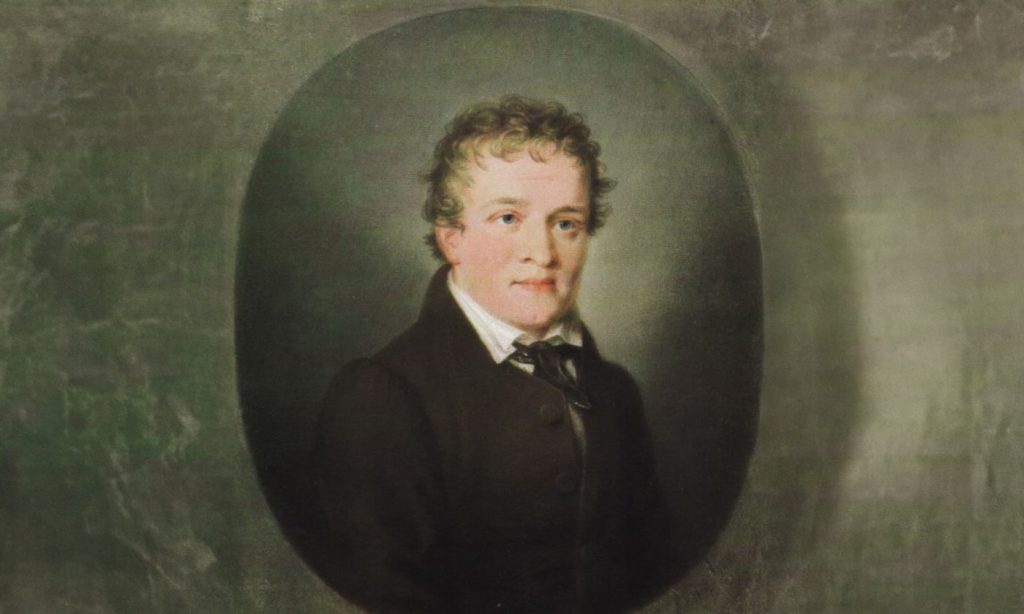Kaspar Hauser first appeared as a teenager on the streets of Nuremberg, Germany in 1828. He was able to write his name, say a few prayers and read a little, but his vocabulary was rather limited. Hauser claimed to be have spent his life in a small dungeon and the only human contact he could recall was with a masked man who fed him bread and water and taught him to write his own name. Over the next five years, Hauser was taken care of by various different people. In each home, the relationship between Hauser and his caregiver would start well, but quickly sour with Hauser’s excessive lies and vanity.
In 1829, he was discovered with a cut wound that he claimed was caused by the man he remembered from his previous life in the dungeon, but many speculated was actually self-inflicted. In December 1833, he returned home with a deep stab wound in his chest. He claimed to have been lured by a stranger to the Ansbach Court Garden, where he was stabbed and given a bag. Police found this bag and an incomplete note apparently from his attacker indicating where he may be found. Hauser’s history of lying lead investigators to examine the note and they determined that it was likely written by Hauser himself, as it contained a spelling and grammar error, and was folded in a specific triangular form, all typical of Hauser. The investigators also believed that Hauser may have stabbed himself, in a bid to revive public interest in his story, but inadvertently stabbed himself too deeply. Hauser died three days later on 17th December 1833.
Was Kaspar Hauser the true Prince of Baden?
The mysterious appearance, unknown origin and apparent assassination of Hauser led many people to believe that he was of princely parentage. The most common belief was that he was the Prince of Baden, the son of Grand Duke Carl von Baden and Stephanie de Beauharnais. Their eldest son had died shortly after birth, but there was a rumor that their true son had been exchanged for a sick child as an attempt to change the succession to another branch of the family. If their true son had been taken away and raised in secret, he would be of the same age as Kaspar Hauser. In 1998, researchers were able to answer this question using DNA analyses of Hauser’s bloodstained clothing.
Genetic analyses of Hauser’s bloodstained clothing
DNA analyses require authentic material from the study subjects. Ideally this is from human remains, but it was unknown whether Hauser’s gravestone was still above the correct grave, due to disturbances in the war. Instead, the researchers elected to use a section of fabric from the blood soaked underpants that Hauser was wearing during his apparent assassination. This clothing had originally been seized by the court after the stabbing and later given to the Historical Society of Ansbach. Mitochondrial DNA (mtDNA) sequencing is the best approach for the analysis of degraded DNA samples, as there are a high number of mtDNA copies per cell so it is more likely to survive for extended periods compared to nuclear DNA. MtDNA is inherited in a strict maternal pattern (mother to child) so it is useful for tracing maternal lineages even when the subject and available references are several generations apart. The references in this study were two living maternal descendants of Stephanie de Beauharnais – the putative mother of Kaspar Hauser. These two descendants will share the same mtDNA profile as Stephanie de Beauharnais and any of her children.
The two hypervariable regions of the mtDNA genome were analyzed from the bloodstained fabric of Hauser by two independent laboratories. The resulting mtDNA profile differed significantly from the profile of the two references.
Conclusions
This study has determined the mtDNA profile of Kaspar Hauser (from the analysis of his bloodstained clothing) and the mtDNA profile of Stephanie de Beauharnais (from the analysis of two living maternal descendants). These two mtDNA profiles are very different, meaning that it is not possible that Hauser was a son of Stephanie de Beauharnais, hence disproving the legend that Hauser was the Prince of Baden. We still do not know the true identity of Hauser, but it is now strongly believed that Hauser was a pathological liar with a hysterical and paranoid personality.

DNA Database Comparisons
The DNA tests conducted in this study have defined the mtDNA profiles of Kaspar Hauser and Stephanie de Beauharnais. If you have taken the mtDNA HVR1 and HVR2 (Advanced Maternal Ancestry) test, you can compare your mtDNA against these individuals to see if you may have descended from the same maternal lineage as either this pathological swindler (Hauser) or German nobility (de Beauharnais).
DNA Ancestry Project Features
Ancestry Test
Mitochondrial DNA sequencing
Y-DNA STR fragment analysis
Autosomal STR fragment analysis
Advanced ethnic origins report
Recent ancestry analysis
Ancient ancestry analysis
DNA Ancestry Projects
Relationship match
Relationship confirmation









